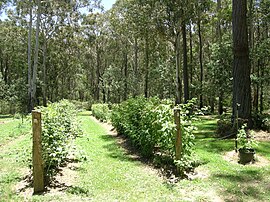Niangala, New South Wales
|
Niangala New South Wales |
|
|---|---|

Koolkuna Berry Farm
|
|
| Coordinates | 31°17′54″S 151°24′34″E / 31.29833°S 151.40944°ECoordinates: 31°17′54″S 151°24′34″E / 31.29833°S 151.40944°E |
| Population | 142 (2011 census) |
| Postcode(s) | 2354 |
| Elevation | 1,300 m (4,265 ft) |
| Time zone | AEST (UTC+10) |
| • Summer (DST) | AEDT (UTC+11) |
| Location | |
| LGA(s) | |
| Region |
New England Hunter |
| County | Parry |
| Parish | Walcha |
| State electorate(s) | Tamworth |
| Federal Division(s) | |
Niangala is a village located on the south-eastern edge of the Northern Tablelands area of New South Wales, Australia. It is on the Moonbi Range which is part of the Great Dividing Range, at approximately 1,300 metres (4,265 ft) above sea level. The village is in Walcha parish in Parry County. At the 2011 census, Niangala and the surrounding area had a population of 142.
Geographically isolated, the village is situated among pine tree plantations. Access to the community requires travel along some stretches of dirt road, which can be hazardous in wet or snow conditions. Winters are cold there, often with several falls of snow during the season.
Niangala, meaning ‘eclipse’, was first known as Bungadore, ‘blackrocks’ and is situated at the head of Bungendore Creek.
In 1836 William Telfer marked a tree line from Port Stephens through Barrington, Nowendoc and on to Ogunbil. The Australian Agricultural Company set up stations and resting places for their travelling sheep along this route to be known as the ‘Peel Line’. This route was steep and rugged but it was much more efficient than the previously used route, via Maitland. The present roads, Thunderbolts Way from Gloucester and the Topdale Road to Tamworth, travel approximately the same route.
Niangala began as a gold mining settlement and by the end of October 1890, Niangala had five boarding houses, two butcheries, one blacksmith, a bakery and two stores. The Niangala post office opened on 1 December 1890 (it closed in 1977). and coach services travelled regularly from Walcha to Niangala. The Public School was opened in 1891 for 28 children of the local gold miners and had one teacher. The school remained a one teacher school until 1980. This School reached its peak enrolment of 51 students in 1991. In 1891 the population was 300 and on 14 September 1893 Niangala was proclaimed a village. During 1901 residents were able to connect to the telephone, but it was not until 1966 that 33 customers accessed rural power.
...
Wikipedia

